A Method for Energy Storage Capacity Configuration in the Power Grid Along Mountainous Railway Based on Chance-Constrained Optimization
Abstract
1. Introduction
- (1)
- This paper adopts a three-phase linear power flow model to develop a linearized calculation method for node voltages, integrating three-phase voltage deviation and imbalance into the optimization objectives.
- (2)
- Chance constraints are introduced to characterize the randomness of renewable energy generation, and the utilization rate of uncertain renewable energy output is included in the optimization framework. The model is transformed into a solvable mixed-integer linear programming (MILP) formulation based on conditional value-at-risk (CVaR) theory.
- (3)
- A novel energy storage configuration method is proposed, which optimizes both three-phase imbalance mitigation and renewable energy utilization. The effectiveness of the proposed method is demonstrated through simulations on a case study of a power grid along a railway in the mountainous region of Southwest China.
2. Energy Storage System Configuration Model for Mountainous Railway Power Grids
2.1. Objective Function
2.2. Constraint Conditions
3. DRCC-Based Energy Storage System Configuration Model Transformation
- Leverages historical renewable generation data without requiring exact probability distributions or fluctuation ranges;
- Incorporates adjustable confidence parameters to control solution conservativeness;
- Enhances configuration/operation flexibility through data-driven uncertainty characterization
3.1. Chance-Constrained Modeling for Uncertain Renewable Energy
3.2. Wasserstein Distance-Based Distributionally Robust Chance-Constrained (DRCC) Model
3.3. Chance-Constrained Model Reformulation
4. Case Study
4.1. Case Study Description
4.2. Case Data
4.3. Analysis of Simulation Results
5. Conclusions
- Energy storage configuration can effectively mitigate voltage fluctuations and three-phase imbalance induced by traction loads. Simulation results demonstrate that compared to systems without energy storage, the implemented energy storage solution reduces overall voltage deviation by 40.7% and improves three-phase voltage imbalance by 16%.
- As the confidence level increases, the system adopts more conservative scheduling strategies for renewable energy output to prevent power shortages. However, this approach reduces renewable energy utilization rates, leading to increased generation costs from conventional power units and higher wind–solar curtailment costs, ultimately resulting in elevated overall operational costs.
Author Contributions
Funding
Data Availability Statement
Acknowledgments
Conflicts of Interest
References
- Zhang, Q.; Zhang, Y.; Huang, K.; Tasiu, I.A.; Lu, B.; Meng, X.; Liu, Z.; Sun, W. Modeling of regenerative braking energy for electric multiple units passing long downhill section. IEEE Trans. Transp. Electrif. 2022, 8, 3742–3758. [Google Scholar] [CrossRef]
- Rezaei, N.; Ahmadi, A.; Khazali, A.H.; Guerrero, J.M. Energy and frequency hierarchical management system using information gap decision theory for islanded microgrids. IEEE Trans. Ind. Electron. 2018, 65, 7921–7932. [Google Scholar] [CrossRef]
- Lu, B.; Song, Y.; Liu, Z.; Wang, X.; Zhang, Q.; Lu, Y. Evolution analysis of three-dimensional wheel polygonal wear for electric locomotives considering the effect of interharmonics. IEEE Trans. Veh. Technol. 2025, 74, 2443–2457. [Google Scholar] [CrossRef]
- Frilli, A.; Meli, E.; Nocciolini, D.; Pugi, L.; Rindi, A. Energetic optimization of regenerative braking for high speed railway systems. Energy Convers. Manage. 2016, 129, 200–215. [Google Scholar] [CrossRef]
- Sun, J.; Su, C.; Song, J.; Yao, C.; Ren, Z.; Sui, Q. Capacity planning for large-scale wind-photovoltaic-pumped hydro storage energy bases based on ultra-high voltage direct current power transmission. Energy 2025, 320, 135224. [Google Scholar] [CrossRef]
- Zhang, X.; Campana, P.E.; Bi, X.; Egusquiza, M.; Xu, B.; Wang, C.; Guo, H.; Chen, D.; Egusquiza, E. Capacity configuration of a hydro-wind-solar-storage bundling system with transmission constraints of the receiving-end power grid and its techno-economic evaluation. Energy Convers. Manag. 2022, 270, 116177. [Google Scholar] [CrossRef]
- Pan, T.; Wang, L.; Ding, H.; Zeng, M.; Zhang, X.; Su, Y.; Zhou, X. Capacity optimization of hybrid energy storage power generation system in regional power system. Acta Energiae Solaris Sin. 2024, 45, 752–763. [Google Scholar]
- Guezgouz, M.; Jurasz, J.; Bekkouche, B.; Ma, T.; Javed, M.S.; Kies, A. Optimal hybrid pumped hydro-battery storage scheme for off-grid renewable energy systems. Energy Convers. Manag. 2019, 199, 112046. [Google Scholar] [CrossRef]
- Deb, K.; Pratap, A.; Agarwal, S.; Meyarivan, T.A.M.T. A fast and elitist multi objective genetic algorithm: NSGA-II. IEEE Trans. Evol. Comput. 2002, 6, 182–197. [Google Scholar] [CrossRef]
- Xu, D.; Zhou, B.; Wu, Q.; Chung, C.Y.; Li, C.; Huang, S.; Chen, S. Integrated modelling and enhanced utilization of power-to-ammonia for high renewable pene-trated multi-energy systems. IEEE Trans. Power Syst. 2020, 35, 4769–4780. [Google Scholar] [CrossRef]
- Wang, B.; Ni, M.; Jiao, K. Green ammonia as a fuel. Sci. Bull. 2022, 67, 1530–1534. [Google Scholar] [CrossRef]
- Zeng, Z.; Zheng, J.; Wei, X. Research on capacity optimization configuration of hydrogen-ammonia hybrid storage sys-tem in microgrid. Guangdong Electr. Power 2024, 37, 42–49. [Google Scholar]
- Fan, J.; Yan, R.; He, Y.; Zhang, J.; Zhao, W.; Liu, M.; An, S.; Ma, Q. Stochastic optimization of combined energy and computation task scheduling strategies of hybrid system with multi-energy storage system and data center. Renew. Energy 2025, 242, 122466. [Google Scholar] [CrossRef]
- Ma, N.; Liu, G.; Wu, J.; Lei, Z.; Wang, Y.; Xin, L. A double-layer robust optimization model for energy storage capacity allocation in the leasing market. Power Syst. Technol. 2025, 49, 653–665. [Google Scholar]
- Zhang, X.; Wang, Z.; Liao, H.; Zhou, Z.; Ma, X.; Yin, X.; Wang, Z.; Liu, Y.; Lu, Z.; Lv, G. Optimal capacity planning and operation of shared energy storage system for large-scale photovoltaic integrated 5G base stations. Int. J. Electr. Power Energy Syst. 2023, 147, 108816. [Google Scholar] [CrossRef]
- Wei, W.; Liu, F.; Mei, S.; Hou, Y. Robust energy and reserve dispatch under variable renewable generation. IEEE Trans. Smart Grid 2015, 6, 369–380. [Google Scholar] [CrossRef]
- Liu, F.; Bie, Z.; Wang, X. Day-ahead dispatch of integrated electricity and natural gas system considering reserve scheduling and renewable uncertainties. IEEE Trans. Sustain. Energy 2019, 10, 646–658. [Google Scholar] [CrossRef]
- Cao, Y.; Wei, W.; Chen, L.; Wu, Q.; Mei, S. Supply inadequacy risk evaluation of stand-alone renewable powered heat-electricity energy systems: A data-driven robust approach. IEEE Trans. Ind. Inform. 2021, 17, 1937–1947. [Google Scholar] [CrossRef]
- Zhang, C.; Li, Y.-F.; Zhang, H.; Wang, Y.; Huang, Y.; Xu, J. Distributionally robust resilience optimization of post-disaster power system considering multiple uncertainties. Reliab. Eng. Syst. Saf. 2024, 251, 110367. [Google Scholar] [CrossRef]
- Li, S.; Liu, Z.; Zeng, Q. Distributionally robust optimization collaborative planning method for transmission network external channel and energy storage with high proportion of renewable energy. Guangdong Electr. Power 2024, 37, 49–59. [Google Scholar]
- Liu, Y.; Zhu, Q.; Miao, L.; Deng, W.; Fan, W.; Xiao, H. Distributed robust reactive power optimization of power systems with offshore wind farms based on synchronous ADMM. Guangdong Electr. Power 2024, 37, 21–31. [Google Scholar]
- Huang, W.; Qian, T.; Tang, W.; Wu, J. A distributionally robust chance constrained optimization approach for securi-ty-constrained optimal power flow problems considering dependent uncertainty of wind power. Appl. Energy 2025, 383, 125264. [Google Scholar] [CrossRef]
- Zhang, M.; Lu, X.; Zhou, H.; Li, X.; Tao, Y.; Hu, A. Multi-station integrated energy storage configuration and optimal operation strategy based on chance constraint. Guangdong Electr. Power 2022, 35, 66–73. [Google Scholar]
- Chen, Y.; Chen, M.; Liang, Z.; Liu, L. Dynamic voltage unbalance constrained economic dispatch for electrified railways inte-grated energy storage. IEEE Trans. Ind. Inform. 2022, 18, 8225–8235. [Google Scholar] [CrossRef]
- Hu, H.; Liao, H.; Huang, Y.; Ge, Y.; Wang, K.; Chen, G.; Guo, X. A Three-Stage Optimization Strategy for Techno-Economic Operation of Railway Flexible Traction Substation. IEEE Trans. Smart Grid 2025, 16, 519–528. [Google Scholar] [CrossRef]
- Huang, Y.; Hu, H.; Ge, Y.; Liao, H.; Luo, J.; Gao, S.; He, Z. Joint sizing optimization method of PVs, hybrid energy storage systems, and power flow con-trollers for flexible traction substations in electric railways. IEEE Trans. Sustain. Energy 2024, 15, 1210–1223. [Google Scholar] [CrossRef]
- Wang, J.; Purewal, J.; Liu, P.; Hicks-Garner, J.; Soukazian, S.; Sherman, E.; Sorenson, A.; Vu, L.; Tataria, H.; Verbrugge, M.W. Degradation of lithium ion batteries employing graphite negatives and nickelecobalteman-ganese oxide þ spinel manganese oxide positives: Part 1, aging mechanisms and life estimation. J. Power Sources 2014, 269, 937–948. [Google Scholar] [CrossRef]
- Yang, J.; Zhang, N.; Kang, C.; Xia, Q. A state-independent linear power flow model with accurate estimation of voltage magni-tude. IEEE Trans. Power Syst. 2017, 32, 3607–3617. [Google Scholar] [CrossRef]
- Fatemi, S.M.; Abedi, S.; Gharehpetian, G.B.; Hosseinian, S.H.; Abedi, M. Introducing a novel dc power flow method with reactive power considerations. IEEE Trans. Power Syst. 2015, 30, 3012–3023. [Google Scholar] [CrossRef]
- Lian, X.; Qian, T.; Li, Z.; Chen, X.; Tang, W. Resilience assessment for power system based on cascading failure graph under disturbances caused by extreme weather events. Int. J. Electr. Power Energy Syst. 2023, 145, 108616. [Google Scholar] [CrossRef]
- Xie, W. On distributionally robust chance constrained programs with Wasserstein distance. Math. Program. 2021, 186, 115–155. [Google Scholar] [CrossRef]
- Nemirovski, A.; Shapiro, A. Convex approximations of chance constrained programs. SIAM J. Optim. 2006, 17, 969–996. [Google Scholar] [CrossRef]
- Hota, A.R.; Cherukuri, A.; Lygeros, J. Data-driven chance constrained optimization under Wasserstein ambiguity sets. In Proceedings of the 2019 American Control Conference (ACC), Philadelphia, PA, USA, 10–12 July 2019. [Google Scholar]
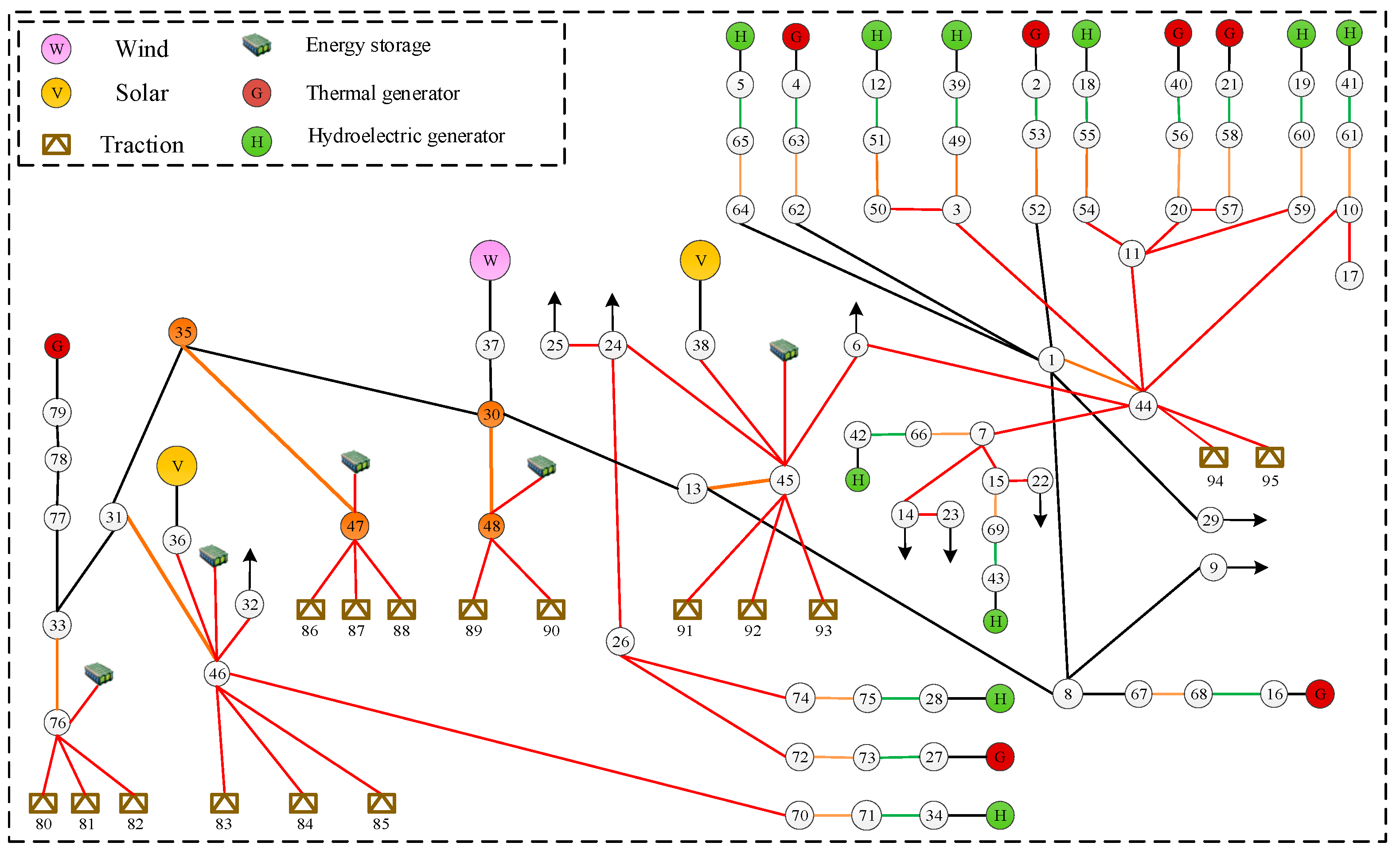
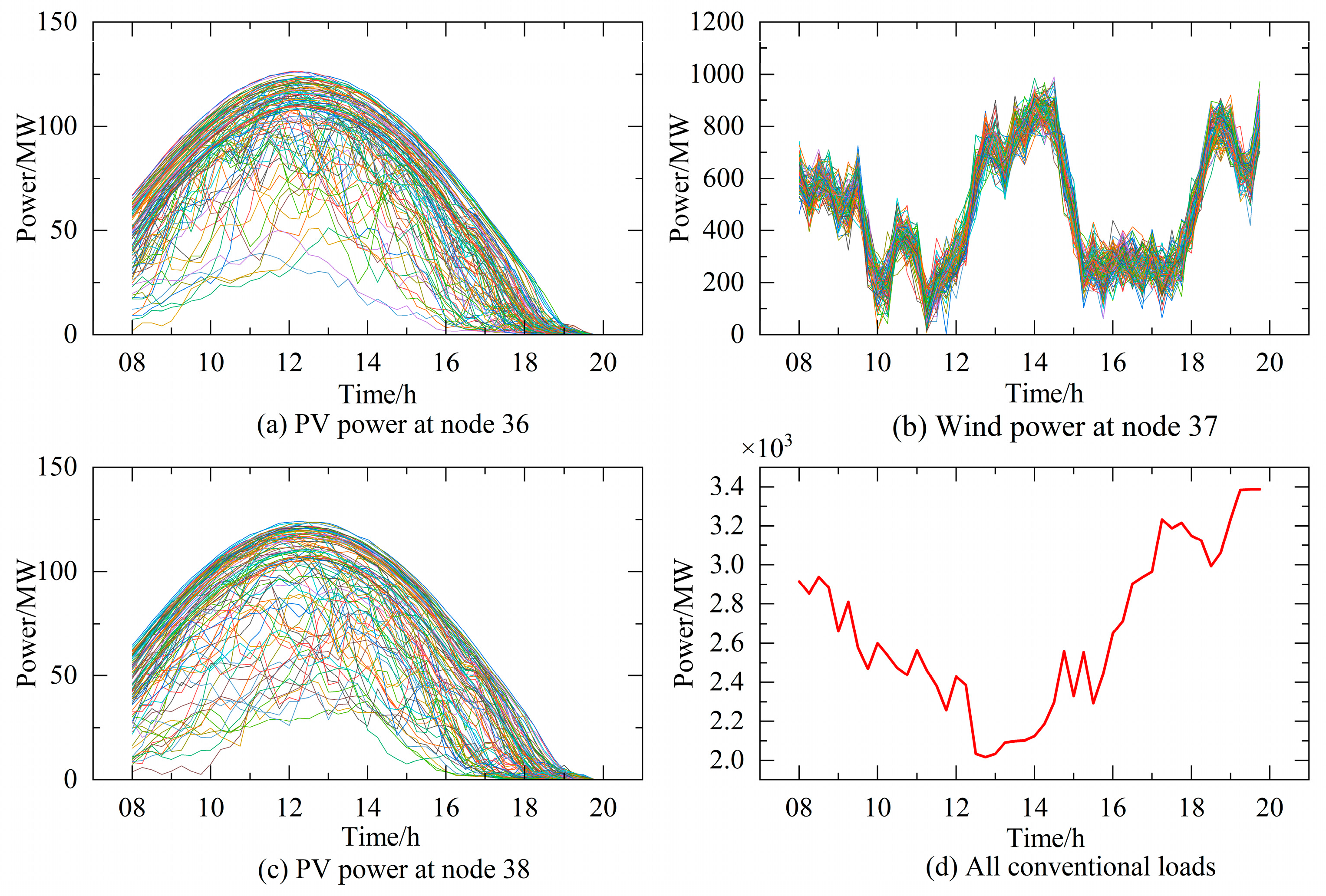
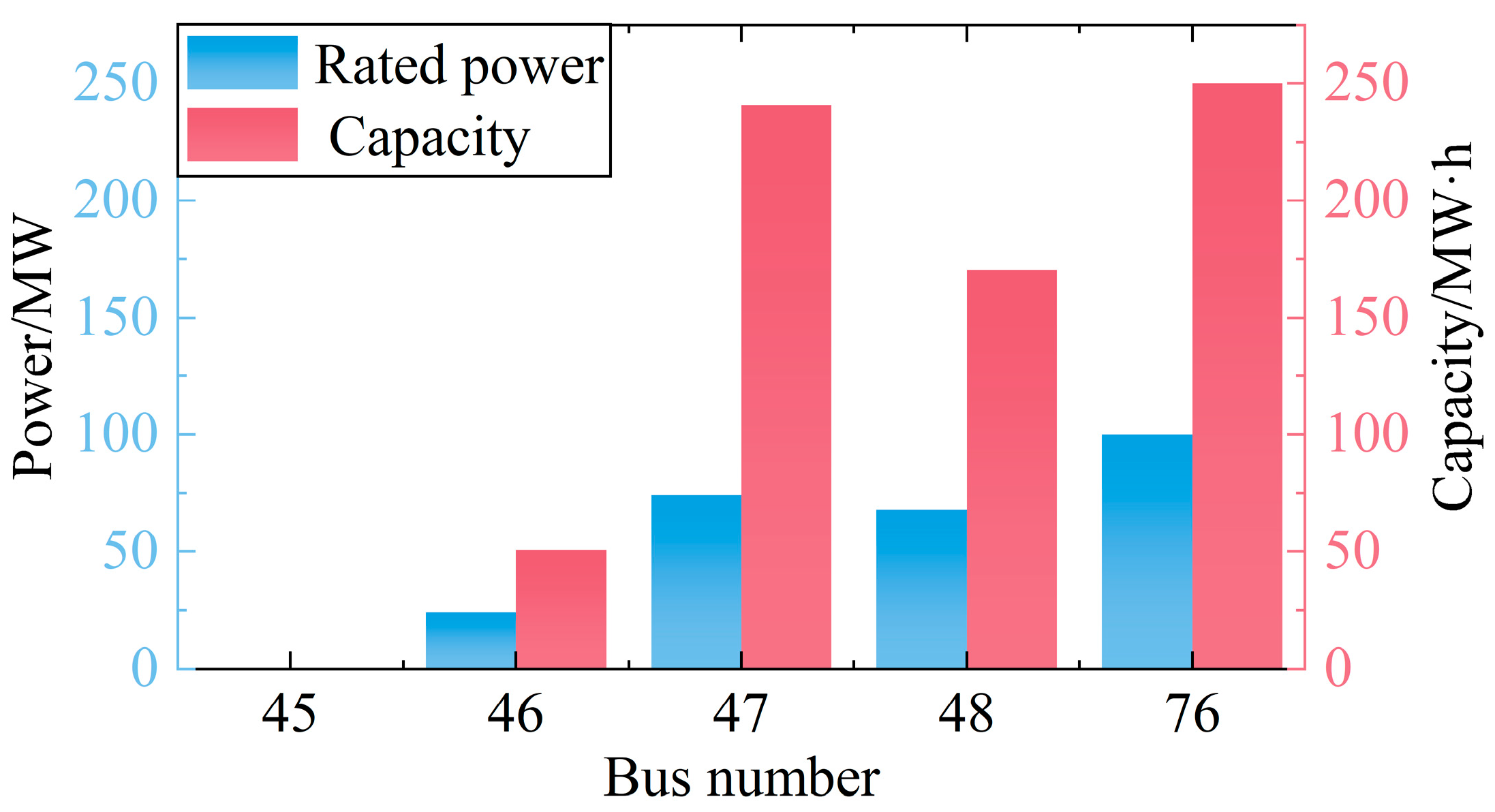
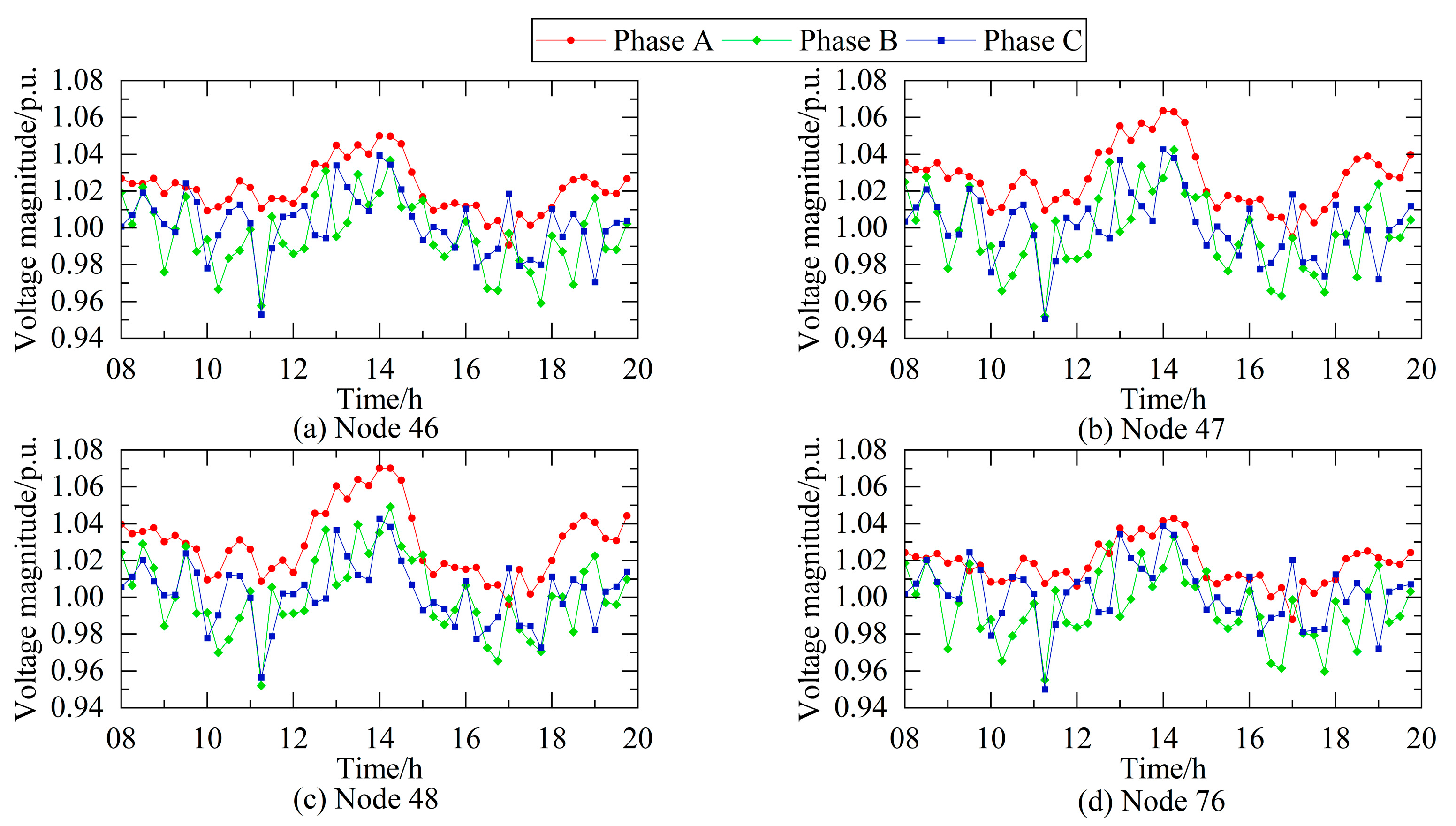

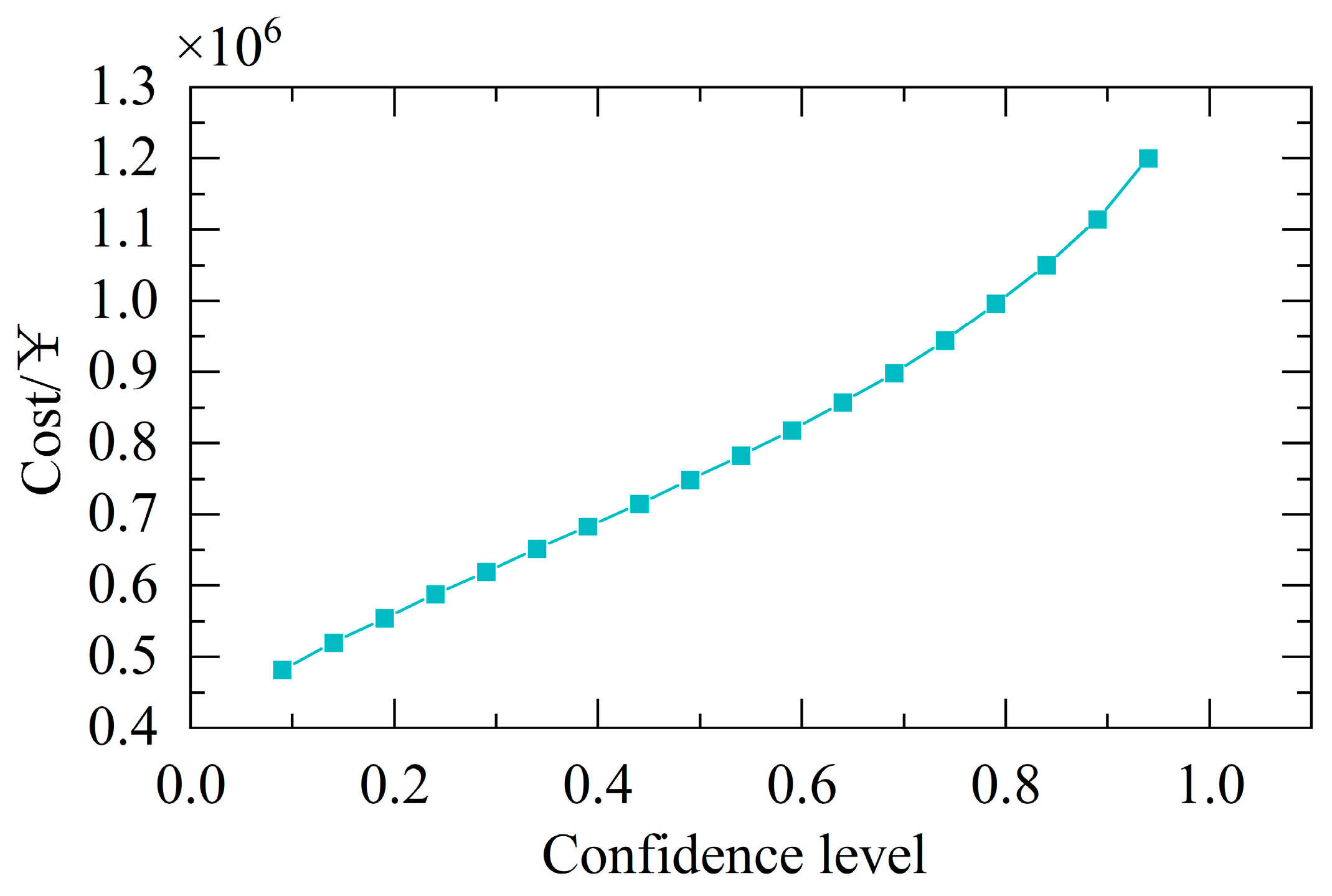

| Parameters | Value | Parameters | Value |
|---|---|---|---|
| (¥/MW) | 1.51 × 106 | cl | 0.2 |
| (¥/MWh) | 1.35 × 106 | cu | 0.6 |
| r (year) | 10 | (MWh) | 0 |
| cch/cdis (¥/MWh) | 50 | (MWh) | 250 |
| Model | Utilization Rates | Cost/¥ | ||
|---|---|---|---|---|
| Node 36 | Node 37 | Node 38 | ||
| DRCC | 67.22% | 89.57% | 60.20% | 7.76 × 105 |
| Deterministic | 50.35% | 72.95% | 47.10% | 9.62 × 105 |
Disclaimer/Publisher’s Note: The statements, opinions and data contained in all publications are solely those of the individual author(s) and contributor(s) and not of MDPI and/or the editor(s). MDPI and/or the editor(s) disclaim responsibility for any injury to people or property resulting from any ideas, methods, instructions or products referred to in the content. |
© 2025 by the authors. Licensee MDPI, Basel, Switzerland. This article is an open access article distributed under the terms and conditions of the Creative Commons Attribution (CC BY) license (https://creativecommons.org/licenses/by/4.0/).
Share and Cite
Liu, F.; Zeng, J.; Liu, J.; Liu, Z.; Zhang, Q.; Lu, Y.; Liu, Z. A Method for Energy Storage Capacity Configuration in the Power Grid Along Mountainous Railway Based on Chance-Constrained Optimization. Energies 2025, 18, 5088. https://doi.org/10.3390/en18195088
Liu F, Zeng J, Liu J, Liu Z, Zhang Q, Lu Y, Liu Z. A Method for Energy Storage Capacity Configuration in the Power Grid Along Mountainous Railway Based on Chance-Constrained Optimization. Energies. 2025; 18(19):5088. https://doi.org/10.3390/en18195088
Chicago/Turabian StyleLiu, Fang, Jian Zeng, Jiawei Liu, Zhenzu Liu, Qiao Zhang, Yanming Lu, and Zhigang Liu. 2025. "A Method for Energy Storage Capacity Configuration in the Power Grid Along Mountainous Railway Based on Chance-Constrained Optimization" Energies 18, no. 19: 5088. https://doi.org/10.3390/en18195088
APA StyleLiu, F., Zeng, J., Liu, J., Liu, Z., Zhang, Q., Lu, Y., & Liu, Z. (2025). A Method for Energy Storage Capacity Configuration in the Power Grid Along Mountainous Railway Based on Chance-Constrained Optimization. Energies, 18(19), 5088. https://doi.org/10.3390/en18195088





